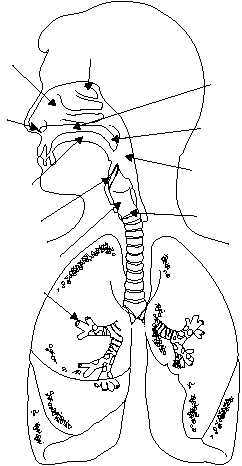chambers of the nasal cavity to prevent damage to the
lungs. The nasal and oral cavities are separated by the
palate. The anterior, rigid portion is called the hard
palate, and the posterior fleshy part is called the soft
palate. The mouth and nose serve as secondary
respiratory structures.
Pharynx
The pharynx, or throat, serves both the respiratory
and digestive systems and aids in speech. It has a
mucous membrane lining that traps microscopic
particles in the air and aids in adjusting temperature
and humidifying inspired (inhaled) air. The pharynx
connects with the mouth and nasal chambers
posteriorly. According to its location, the pharynx is
referred to as the nasopharynx posterior to the nasal
chambers), the oropharynx (posterior to the mouth),
or the laryngopharynx (posterior to the pharynx).
Epiglottis
The epiglottis is a lidlike, cartilaginous structure
that covers the entrance to the larynx and separates it
from the pharynx. It acts as a trap door to deflect food
particles and liquids from the entrance to the larynx
and trachea.
Larynx
The larynx, or voice box, is a triangular
cartilaginous structure located between the tongue and
the trachea. It is protected anteriorly by the thyroid
cartilage (commonly called the Adam's apple), which
is usually larger and more prominent in men than in
women. During the act of swallowing, it is pulled
upward and forward toward the base of the tongue. The
larynx is responsible for the production of vocal sound
(voice). This sound production is accomplished by the
passing of air over the vocal cords. The ensuing
vibrations can be controlled to produce the sounds of
speech or singing. The nose, mouth, throat, bone
sinuses, and chest serve as resonating chambers to
further refine and individualize the voice.
Trachea
The trachea, or windpipe, begins at the lower end
of the larynx and terminates by dividing into the right
and left bronchi. It is a long tube composed of 16 to 20
C-shaped cartilaginous rings, embedded in a fibrous
membrane, that support its walls, preventing their
collapse (fig. 1-39).
The trachea has a ciliated mucous membrane
lining that entraps dust and foreign material. It also
propels secretions and exudates from the lungs to the
pharynx, where they can be expectorated.
Bronchi
The bronchi are the terminal branches of the
trachea, which carry air to each lung and further divide
into the bronchioles.
Bronchioles
The bronchioles are much smaller than the bronchi
and lack supporting rings of cartilage. They terminate
at the alveoli (fig. 1-40).
Alveoli
The alveoli are thin, microscopic air sacs within
the lungs (fig. 1-40). They are in direct contact with the
pulmonary capillaries. It is here that fresh oxygen
exchanges with carbon dioxide by means of a diffusion
process through the alveolar and capillary cell walls
1-34
HM3F0139
NOSTRIL
SINUS
NASAL
CAVITY
HARD
PALATE
SOFT
PALATE
PHARYNX
LARYNX
BRONCHUS
RIGHT
LUNG
LEFT
LUNG
EPIGLOTTIS
TRACHEA
ORAL
CAVITY
Figure 1-39.—Organs of the respiratory system.

